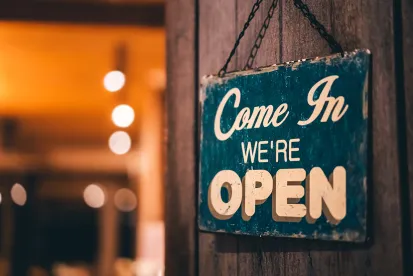The Connecticut Department of Economic and Community Development (DECD) has released its guidance for the reopening of the following five sectors of the state’s economy:
-
Restaurants (Outdoor Only)
-
Museums and Zoos (Outdoor Only)
Reopening after the COVID-19 shutdown in these sectors will be a litmus test for the feasibility and practicality of additional reopening guidance in Connecticut’s multi-phased approach.
General Requirements
While the guidance provides each sector requirements particular to its industry, the following are the common requirements across all sectors:
-
Program Administrator – Each employer should appoint a Program Administrator who will be responsible for implementing the reopening related rules.
-
Self-Certification – Any business that seeks to reopen on or after May 20, 2020, will be required to follow the guidance applicable to its sector. The DECD will require businesses to complete a self-certification online, and it will provide the business a “Reopen Connecticut” badge to display on-site, on social media, or its website.
-
Training – Before and after reopening, employers must train employees on (1) the particular rules for their sector and (2) protocols on how to clean, including how to properly use cleaning products. Importantly, this training must be provided at no cost to the employee and during working hours, and the training materials must be presented in the language and at the literacy level of the employees. Weekly refreshers on policies also are required.
-
Employee Health – Employers are to ask returning employees to confirm they have not experienced COVID-19 symptoms (cough, shortness of breath, or any two of the following symptoms: fever, chills, repeated shaking with chills, muscle pain, headache, sore throat, or new loss of taste or smell) and to continue self-monitoring. Sick employees must remain home.
Consistent with Governor Ned Lamont’s previous order for essential businesses, employers must provide a face mask or other face covering for employees to wear at work, unless doing so would be contrary to an employee’s health or safety due to medical conditions. (Customers are expected to do the same.) Subject to that exception, the mask must be utilized when the employee is working in a non-segregated space. Gloves and eye protection must be provided to employees working with cleaning chemicals. If employers expect to reopen, the guidance recommends that they begin estimating the necessary amounts of masks, gloves, and eye protection (PPE) needed, and begin procuring it.
-
Reporting – Employers must post clear signage that includes the state hotline (211) for employees and customers to report potential violations of these rules. Employers are prohibited under the Occupational Safety and Health Act (OSHA) or its state counterpart (ConnOSHA) from retaliating against employees who raise concerns about COVID-19-related safety and health conditions.
-
Operations – The guidance limits capacity to 50 percent. Social gatherings (including customers at restaurant tables or in-person office meetings) are limited to five people, and social distancing measures should be implemented where possible. A cleaning checklist should be generated that incorporates the rules. Employees on premises should be logged to support contact tracing. Signage should be created that reinforces the policies on social distancing, cleaning, PPE, and employee self-monitoring. To the extent possible, shifts should be staggered to minimize employee interaction. Touchless appliances should be installed and utilized (such as payment kiosks, soap and paper towel dispensers, and garbage bins with lids). Non-essential amenities (such as self-serve samples, magazines, games, coat rooms, and coffee or water stations) should be removed.
Particular Sectors
Each sector will be required to comply more particularly with its respective guidance and provide training on the same. Critical highlights include the following (consult the relevant guidance for a complete list of requirements for each sector):
Restaurants
Restaurants will be permitted to reopen outdoor seating only, at 50-percent capacity and for parties of up to five. Interaction between customers and staff should be limited, with single-use menus and condiments provided. Kitchen and dining operations should be structured to designate discrete zones for employees to work in without overlapping with others.
Offices
Offices are permitted to reopen at 50-percent capacity, to the extent necessary. Working from home is still encouraged. Prior to reopening, a thorough cleaning of all common areas and touch points should be undertaken. Physical modifications to the office environment should be made where possible to create six feet of distance, which may include marking desks that should not be used or installing partitions if social distancing cannot be accomplished.
Retail & Malls
Retail and mall operations are permitted to reopen at 50-percent capacity. Fitting rooms must be closed. Visual social distancing markers should be used in high-traffic areas, such as near checkout kiosks or bathroom lines. Physical barriers should be installed at checkout stations. Discrete work areas should be assigned to employees to limit overlap throughout the store.
Dining areas in malls are subject to the restaurant guidance. Increased security should be provided to enforce the rules and limit congregating patrons, as well as to ensure that takeout food is not consumed in the mall.
Hair Salons & Barbershops
Hair salons and barbershops may reopen by appointment only. Waiting rooms are to be closed. Equipment may not be shared among employees, and workstations must be rearranged to allow for six feet between customers (or partitions must be installed). The guidance also specifically requires “signage in multiple languages where employees and/or clientele are not native English speakers.” Employees are required to wear face shields and a face mask or other cloth face covering that completely covers the nose and mouth, unless doing so would be contrary to their health or safety due to medical conditions. Gloves are optional when working with customers, but must be changed between customers if used.
Museums and Zoos
Museums and zoos may reopen their outdoor exhibits only; all interactive or indoor exhibits are to remain closed. Occupancy is to be calculated per exhibit area or room, to allow for social distancing. Attendants should be stationed at discrete work areas, without overlap. Gift shops and dining options are to remain closed. Guided group tours are not permitted. Floor markings should be installed to direct one-way flow where possible.





 />i
/>i
